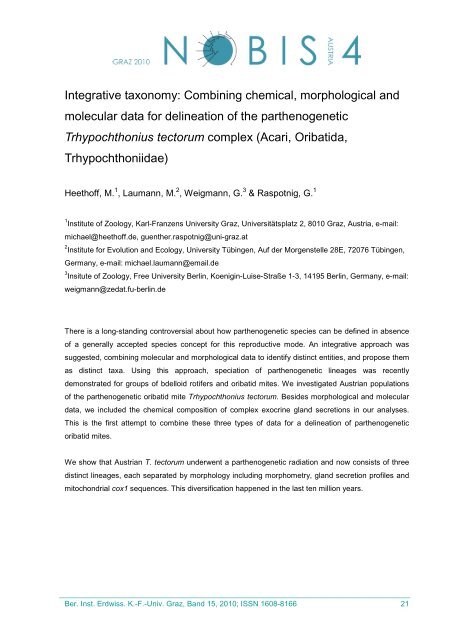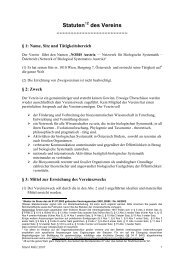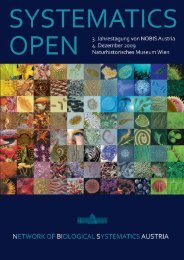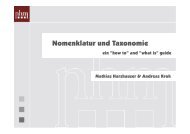4. Jahrestagung von NOBIS Austria 2. - 3. Dezember 2010
4. Jahrestagung von NOBIS Austria 2. - 3. Dezember 2010
4. Jahrestagung von NOBIS Austria 2. - 3. Dezember 2010
Create successful ePaper yourself
Turn your PDF publications into a flip-book with our unique Google optimized e-Paper software.
Integrative taxonomy: Combining chemical, morphological and<br />
molecular data for delineation of the parthenogenetic<br />
Trhypochthonius tectorum complex (Acari, Oribatida,<br />
Trhypochthoniidae)<br />
Heethoff, M. 1 , Laumann, M. 2 , Weigmann, G. 3 & Raspotnig, G. 1<br />
1 Institute of Zoology, Karl-Franzens University Graz, Universitätsplatz 2, 8010 Graz, <strong>Austria</strong>, e-mail:<br />
michael@heethoff.de, guenther.raspotnig@uni-graz.at<br />
2 Institute for Evolution and Ecology, University Tübingen, Auf der Morgenstelle 28E, 72076 Tübingen,<br />
Germany, e-mail: michael.laumann@email.de<br />
3 Insitute of Zoology, Free University Berlin, Koenigin-Luise-Straße 1-3, 14195 Berlin, Germany, e-mail:<br />
weigmann@zedat.fu-berlin.de<br />
There is a long-standing controversial about how parthenogenetic species can be defined in absence<br />
of a generally accepted species concept for this reproductive mode. An integrative approach was<br />
suggested, combining molecular and morphological data to identify distinct entities, and propose them<br />
as distinct taxa. Using this approach, speciation of parthenogenetic lineages was recently<br />
demonstrated for groups of bdelloid rotifers and oribatid mites. We investigated <strong>Austria</strong>n populations<br />
of the parthenogenetic oribatid mite Trhypochthonius tectorum. Besides morphological and molecular<br />
data, we included the chemical composition of complex exocrine gland secretions in our analyses.<br />
This is the first attempt to combine these three types of data for a delineation of parthenogenetic<br />
oribatid mites.<br />
We show that <strong>Austria</strong>n T. tectorum underwent a parthenogenetic radiation and now consists of three<br />
distinct lineages, each separated by morphology including morphometry, gland secretion profiles and<br />
mitochondrial cox1 sequences. This diversification happened in the last ten million years.<br />
_____________________________________________________________________________<br />
Ber. Inst. Erdwiss. K.-F.-Univ. Graz, Band 15, <strong>2010</strong>; ISSN 1608-8166 21






